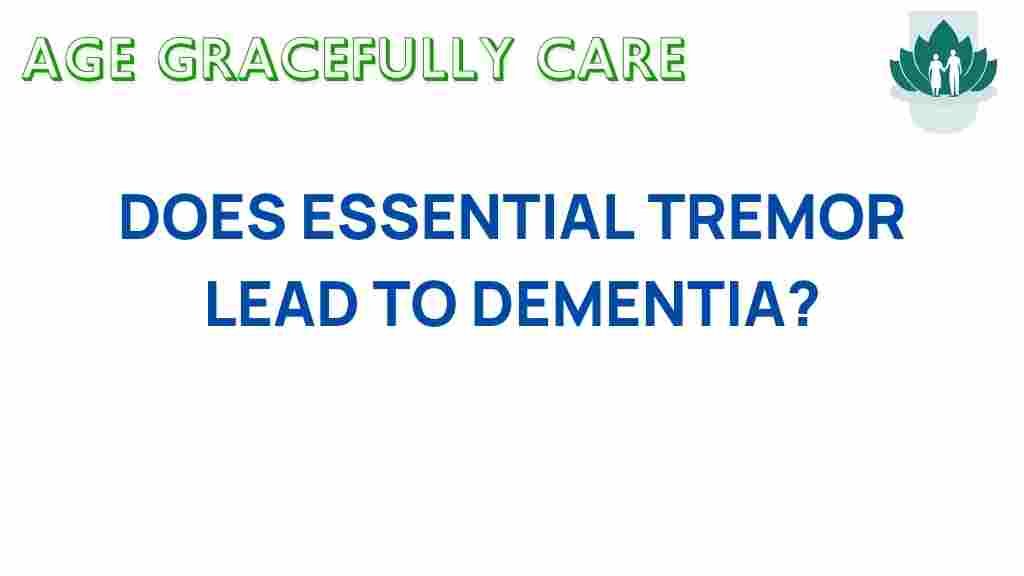Unraveling the Connection: Does Essential Tremor Lead to Dementia?
Essential tremor (ET) is a common neurological disorder that primarily affects the motor system, leading to involuntary shaking or trembling, usually in the hands and arms. As individuals age, the prevalence of essential tremor increases, creating concerns about potential health risks, including cognitive decline and dementia. In this article, we will explore the relationship between essential tremor and dementia, examining how these conditions may be interconnected and what it means for patient care and brain health.
Understanding Essential Tremor
Essential tremor is often confused with other movement disorders, but it is distinct in its characteristics:
- Involuntary shaking: The tremors are typically most noticeable when the affected person is trying to perform tasks like eating or writing.
- Genetic factors: Essential tremor can run in families, suggesting a hereditary component.
- Progressive nature: While it is not life-threatening, essential tremor can worsen over time, impacting daily life.
Understanding essential tremor is crucial in distinguishing it from other neurological disorders and assessing its potential impacts on overall health.
The Link Between Essential Tremor and Cognitive Decline
Recent studies have suggested that individuals with essential tremor may be at a higher risk for cognitive decline and dementia. The mechanism behind this connection is still being researched, but several theories have emerged:
- Neurodegeneration: Both essential tremor and dementia may share common neurodegenerative pathways, leading to overlapping symptoms.
- Chronic stress: The challenges of living with essential tremor can lead to increased stress and anxiety, which are known risk factors for cognitive decline.
- Brain health: Essential tremor may affect brain structures involved in cognition, potentially leading to deficits in memory and thinking abilities.
Understanding these connections is vital for developing effective patient care strategies that address both motor and cognitive symptoms.
Recognizing the Symptoms of Dementia
As we explore the potential consequences of essential tremor on cognitive health, it’s essential to recognize the symptoms of dementia:
- Memory loss: Difficulty recalling recent events or important dates.
- Difficulty concentrating: Struggling to focus on tasks or conversations.
- Confusion: Getting lost in familiar places or having trouble following routines.
- Changes in mood: Experiencing mood swings or withdrawal from social activities.
If you or a loved one exhibits these symptoms alongside essential tremor, it may be time to consult a healthcare professional.
Assessing Health Risks in Aging Populations
Aging is a significant factor when it comes to neurological disorders. As individuals age, their risk for both essential tremor and dementia increases. Here are some health risks to consider:
- Increased prevalence: Studies indicate that up to 50% of older adults may experience essential tremor.
- Comorbidities: Older adults often have other health conditions that can exacerbate symptoms of both essential tremor and dementia.
- Medication interactions: Some medications used for essential tremor may have side effects that impact cognitive function.
Understanding these health risks is crucial for improving patient care and ensuring better outcomes for individuals with essential tremor as they age.
Step-by-Step Process: Managing Essential Tremor and Monitoring Cognitive Health
Managing essential tremor while monitoring for signs of cognitive decline requires a comprehensive approach. Here’s a step-by-step process:
- Consult a specialist: Begin with a neurologist who can diagnose essential tremor and assess cognitive function.
- Create a management plan: Work with healthcare providers to develop a personalized treatment plan that may include medications, therapy, and lifestyle changes.
- Monitor symptoms: Keep a journal of tremor severity and any cognitive changes. This information can be invaluable for healthcare providers.
- Engage in cognitive activities: Encourage participation in activities that stimulate brain health, such as puzzles, reading, or socializing.
- Regular check-ups: Schedule follow-up appointments to assess the progression of essential tremor and monitor cognitive health.
This structured approach can help manage symptoms effectively and improve overall well-being.
Troubleshooting Tips for Patient Care
For caregivers and patients dealing with essential tremor, implementing strategies to ease daily challenges is essential. Here are some troubleshooting tips:
- Adaptive devices: Utilize utensils and tools designed for individuals with tremors, such as weighted utensils or grips.
- Organized environment: Keep living spaces tidy and organized to reduce frustration and accidents.
- Mindfulness practices: Encourage relaxation techniques such as meditation or yoga to help manage stress.
- Support groups: Connect with local or online support groups for individuals with essential tremor to share experiences and coping strategies.
Implementing these tips can improve daily life and provide emotional support for both patients and caregivers.
Conclusion: Understanding the Complex Interplay Between Essential Tremor and Dementia
The relationship between essential tremor and dementia is an area of active research. While essential tremor itself does not directly cause dementia, the potential for cognitive decline in individuals with essential tremor is a significant concern. Understanding this connection is vital for patient care, especially as the population ages.
By recognizing the symptoms of both essential tremor and dementia, assessing health risks, and implementing effective management strategies, we can improve the quality of life for those affected. Ongoing research will continue to unravel the complexities of these neurological disorders and their impacts on brain health.
For more information on neurological disorders, you can visit this resource. If you’re looking for support or more information on managing essential tremor, check out this website.
This article is in the category Health and created by AgeGracefullyCare Team
